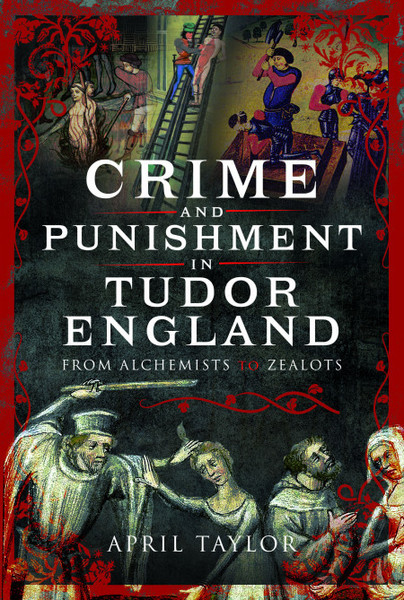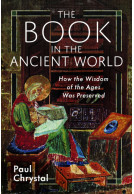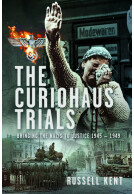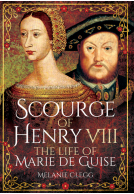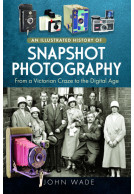Crime and Punishment in Tudor England (Hardback)
From Alchemists to Zealots
Imprint: Pen & Sword History
Pages: 224
Illustrations: 32 mono
ISBN: 9781399071666
Published: 20th September 2023
(click here for international delivery rates)
Order within the next 5 hours, 1 minute to get your order processed the next working day!
Need a currency converter? Check XE.com for live rates
| Other formats available - Buy the Hardback and get the eBook for £1.99! | Price |
|---|---|
| Crime and Punishment in Tudor… eBook (15.7 MB) Add to Basket | £6.99 |
Crime and Punishment in Tudor England tells the story of the enactment of law and its penalties from Henry VII to Elizabeth I. The sixteenth century was remarkable in many ways. In England, it was the century of the Tudor Dynasty. It heralded the Reformation, William Shakespeare, the first appearance of bottled beer in London pubs, Sir Francis Drake, and the Renaissance. Oh, and the Spanish Armadas—all five of them! Yes, five armadas and all failures.
It was a watershed century for crime and punishment. Henry VII’s paranoia about the loyalty of the nobility led to military-trained vagrants causing mayhem and murder. Henry VIII’s Reformation meant executions of those refusing to take the Oath of Supremacy. State-controlled religion—summed up through the five reigns as Roman Catholic; Anglo-Catholic; Protestant; Roman Catholic, and Sort of Protestant but I don’t mind so long as you swear the Oath of Supremacy—became an increasingly complex, not to say confusing, issue for ordinary people.
Although primary sources are rare and sometimes incomplete, the life of criminals and the punishments meted out to them still fascinates. Read about John Daniell and how he tried to blackmail the Earl of Essex; the Stafford insurrection of 1486, the first serious opposition to the new king; the activities of con-man extraordinaire, Gregory Wisdom, and many more.
Crime and punishment didn’t start with the Tudors and this book summarises judicial practices built on tradition from the Roman occupation. It covers often gory details—what happens to the body when it is beheaded, burned, boiled, or hanged? Arranged in alphabetical order of crimes, it recounts tales of blackmail, infanticide, kidnapping, heresy, and sumptuary laws.
Told with occasional low-key humour, the book also includes Tavern Talk, snippets of quirky information. Dip into it at your pleasure.
Rating: 5 out of 5 stars
NetGalley, Neveen Badr
In *Crime and Punishment in Tudor England*, April Taylor offers an absorbing and meticulously detailed survey of law, justice, and transgression during one of England’s most turbulent and ideologically charged eras. Traversing the reigns of monarchs from Henry VII to Elizabeth I, this work examines not only the crimes committed, but the social anxieties, political machinations, and evolving legal doctrines that informed the brutal and often performative nature of Tudor justice.
The book is structured thematically rather than chronologically, which allows Taylor to present readers with a rich tableau of criminal categories—from sorcery, heresy, and treason to vagrancy, theft, and rebellion. Each chapter functions as a window into both the psyche of Tudor governance and the precarious lives of its subjects. What emerges is a portrait of a society governed as much by fear and spectacle as by principle.
Taylor excels in making historical content both intelligible and compelling, without sacrificing academic integrity. Her prose is engaging and laced with sharp contextual insights. She neither sensationalizes the macabre nor moralizes the harshness of Tudor punishments; rather, she presents a clear-eyed view of a justice system that sought to reinforce monarchical authority, religious orthodoxy, and rigid social hierarchies.
The book is particularly commendable for its attention to nuance. Taylor explores how enforcement of the law varied by gender, class, and religion, revealing the profound inequalities embedded within the Tudor legal apparatus. Cases of alchemists accused of sedition, women prosecuted for witchcraft, or political dissenters branded as heretics are not only documented—they are interrogated for what they reveal about power, ideology, and fear in early modern England.
**Final Verdict**:
*Crime and Punishment in Tudor England* is an engrossing and expertly crafted exploration of justice in a time when crime was often indistinguishable from dissent, and punishment served as both retribution and warning. For historians, true crime enthusiasts, and readers intrigued by the intersection of law and monarchy, Taylor offers a narrative as chilling as it is illuminating.
Rating: 5 out of 5 stars
NetGalley, Jamie Lovett
What an incredible read! April Taylor’s Crime and Punishment in Tudor England was well researched, informative, and fascinating! Crime and Punishment in Tudor England tells the story of the laws and penalties during the Tudor period.
Rating: 5 out of 5 stars
NetGalley, Ionia Froment
If you're looking for a lively and thought-provoking romp through Tudor history, April Taylor's 'Crime and Punishment in Tudor England' may be just the thing.
This engaging read isn't your dry academic tome, but a witty exploration of how justice has hilariously, and sometimes horrifyingly, transformed over time. Taylor's knack for weaving in real-world examples – from petty offenses punished with public humiliation to gruesome executions for seemingly minor crimes – will make you chuckle, flinch, and reflect on the evolution of legal systems.
While not exhaustive in its analysis, the book's accessible voice and vibrant anecdotes make it a perfect fit for history buffs, true crime enthusiasts, and anyone curious about the quirky, often brutal, realities of Tudor society. Buckle up for a rollercoaster ride through history, where gallows humor meets fascinating facts, leaving you both entertained and contemplating the ever-changing concept of justice."
I really enjoyed reading this and would encourage other history buffs to give it a read. I had fun with this one.
Rating: 5 out of 5 stars
NetGalley, Lional Jones
An interesting book covering crime and punishment in Tudor times. Crime and punishment evolved from Roman times. Many interesting facts well researched I would recommend this book to all who love history.
As featured on British Murders: A True Crime Podcast episode #45
British Murders
Rating: 5 out of 5 stars
NetGalley, Kelsey Fischer
Crime and Punishment in Tudor England was something that I have been fascinated about for years, but resources are not as readily available in this wonderful and easy to read format. Its very fascinating to see the similarities and differences of how justice is perceived in this era versus now, and its also interesting to see how we as a Western society have never really changed.
Anyone who enjoys reading about the Tudor era in England, or honestly, any true crime junkie will find this book very interesting and informative and a great asset to have on any bookshelf!
An interesting and accessible account of the legal system, criminal justice and punishments during the Tudor era.
NetGalley, Anna Mazzola
Rating: 5 out of 5 stars
NetGalley, Sharon Connolly
I have to admit, Crime and Punishment in Tudor England: From Alchemists to Zealots by April Taylor is one of the best non-fiction books I have had the pleasure of reading this year. I have always had a fascination for the law – I was even considering it as a career at one stage, until I realised I couldn’t stand the 9 to 5 lifestyle. Give me shift work and odd hours any day! So, I have been looking forward to this book ever since I heard April was writing it.
Opening with a fabulous history of the development of England’s legal system, Crime and Punishment in Tudor England explains not only the crimes committed, but also the various legal processes under different monarchs and at different social levels. Every crime imaginable is covered, from infanticide to treason. And so are the punishments and the reasons behind them; and how often such punishments were intended to fit the crime – or to shame the perpetrator. Every part of the criminal justice system is analysed, from religious offenders to witchcraft, from capital punishment to torture, prison condition and labour camps. Crime and Punishment in Tudor England also looks into the influences on crime, such as the impact of economic and social conditions, in a century of religious and political upheaval throughout Europe.
I do have to warn you: this book is not to be read while eating, unless you have a strong stomach. April Taylor includes descriptions of the various methods of execution, including beheading, hanging, burning and the particularly gruesome method of boiling alive!
While some of the more sensational and high profile cases are discussed – such as Anne Boleyn and Catherine Howard – April also introduces cases far less familiar to the reader. Encompassing murder, fraud, blackmail and all manner of crimes, April Taylor presents a fascinating insight into Tudor crimes, ably supported by actual – and fascinating – case studies. Theses case studies not only demonstrate the nature of crimes and their punishment, but also the changing attitudes to crime, and the shifting emphasis on punishments, from the dawn of the Tudor period to the royal dynasty’s demise in 1603.
Crime and Punishment in Tudor England also highlights various miscarriages of justice, including where officials accused innocent victims with the aim of appropriating their goods and property. There are some truly harrowing tales, such as the youngest felon executed in the Tudor era – a girl of the tender age of 11 – and the general treatment of children who fell foul of the criminal justice system. It makes you happy to be living in the 21st century!
April Taylor has managed to cram so much information into Crime and Punishment in Tudor England: From Alchemists to Zealots it really is an impressive tome. It is thorough and well referenced and is written in a lively, entertaining writing style, with a fair amount of wit thrown in for good measure.
I cannot recommend it highly enough. Crime and Punishment in Tudor England: From Alchemists to Zealots is a pleasure to read!
Well I am certainly glad I did not grow up during the Tudor Era in England. Eek- the punishments they came up with for certain crimes did not sound fun. Many were extremely gruesome. But this book was very interesting, and I was able to answer a couple questions on Jeopardy because of what I learned from this book! So that’s always fun.
NetGalley, Paige Schroeder
I really liked the “Tavern Talk” sections of this book- it was a nice way to break things up and introduce a fun new tidbit. I liked that the author included case studies for the crimes, as well.
📖 Read if 📖 :
✔️ You want to supply all of your friends with gruesome tidbits about ways people used to be “punished”
✔️ You love learning about the Tudor era
✔️ You’re a history buff
Fantastic work! The author did some great research for this book. Some I knew and alot was new to me!
NetGalley, Katie Jamison
Rating: 5 out of 5 stars
NetGalley, Andrea Romance
Despite the paucity of primary sources, this book recounts intriguing tales of lawbreakers and the sanctions they faced. Tracing punishments back to ancient Rome, the author describes the penalties for offenses ranging from blackmail to violating sumptuary laws. It also explains the effects of various means of capital punishment on the body. Arranged alphabetically by crime, the book illuminates past judicial customs and the severe sentences once dealt for infringements we now view as minor. Well-researched yet highly readable, it offers a fascinating glimpse into the bloody history of crime and punishment.
Taylor turns crime and punishment in the Tudor period into a fascinating read, while the alpha-order format makes it easy to browse through or do research.
NetGalley, Robin Mason
Great research done by the author on this book. I love history and this particular era has always intrigued and fascinated me. I recommend this book to fans of true crime as well as history buffs!
NetGalley, Jayne Tarry
Rating: 5 out of 5 stars
NetGalley, Kathryn McLeer
This was a unique concept for a nonfiction novel, it has a great feel to it and I enjoyed figuring out what was going on in the crime and punishment in this time-period. April Taylor has a great writing style and it left me wanting to read more from the author.
Rating: 5 out of 5 stars
NetGalley, Andreia Nuno
Now here’s a wonderful find!
>From torture to escaping the law during the Tudor age, this book explores all the nooks and grannies of the legal system between 1485 and 1603.
However, this is far from being a boring read. While April Taylor refers to the legal system, how it worked and the consequences of each crime, she took me on an informative and fun ride. Her style of writing and her occasion humour made this book a complete surprise for someone who was expecting a dense and heavy book. Taylor makes it very easy to understand who things worked during this period through simple language and by providing examples.
The book is divided into two parts. The first one explains the creation of the legal system of the time, and how it’s follows the same base as the Roman laws. The second part (my favourite) takes a look at case studies of criminal trials in the Tudor age. They are organised by type of crime and how the different laws apply. Crime go from alchemy, blackmail, blasphemy to poisoning, kidnapping, prostitution, theft and treason, just to name a few.
The depth of research of this book is truly incredible with an impressive and extensive bibliography.
I highly recommend this book for any history buffs or lovers of the Tudor age!
It's very well constructed and organized. It touches on every crime and gives one or more examples of each. It's thoroughly researched and easy to follow. A short and enlightened read for all of us, Tudor enthusiasts, who want to know more about the laws and punishments of that era.
NetGalley, Sira Barbeito
Rating: 5 out of 5 stars
NetGalley, Pam Small
This book is not is a presentation of dry, dusty, and dense facts; rather, it pushed a light on the legal practices of the day enabling the reader to understand the way of life between 1485 and 1603 by reference to its legal system, its criminal fraternity, and the consequences for crime.
The book is divided into two sections:
Part 1 addresses the the formation of the laws of the land. The tenets of the law have their basis in Roman law; it is so interesting how laws were based on those already established in the Roman Empire. Various Kings visited Rome and were influenced. It also addresses how the clergy and monarch confluences played major roles in the development of laws, and the tension that arose between the monarch and religious sides ( aka Sir Thomas Moore and Beckett).
Part 2 offers a fascinating look into the case studies of criminal trials in Tudor England. The crimes are organized by the type of offense, from laws concerning alchemy and animals to witchcraft and xenophobia! INTERESTING!
Part 1- Although there is so much more explanation and delineation in the book concerning the history of the formation of the legal system, I want to include some interesting highlights:
The Emperor Constantine decreed in 325AD that Christianity was the state religion and this, naturally, applied to Britain. After the Romans left, it was not until St Augustine visited Canterbury with a group of Benedictine monks in 596AD, that the link between the English and the Roman Church was reinstated. This was vital because the courts that dealt with most crimes were church courts. INTERESTING!!!
King Aethelbert (600 Ad) was the first king to put laws in writing and this set the custom for the future. King Aethelbert framed his laws in the Roman way. Prior to his reign, the law of England was defined by the clergy. King Aethelbert also instituted the Writ and the Jury. INTERESTING!!!
King Alfred visited Rome in his youth. He formed ‘The Laws of King Alfred’, picking parts of previously laid down laws that he considered were beneficial to the nation. Previous laws had dealt in the main with theft and trading, but Alfred’s laws included the breaking of oaths, injuries and sexual offenses.
King Canute ruled England from 1016-1035. He also visited Rome and put many statutes into law, becoming known in the process as ‘the greatest legislator of the eleventh century’.
The Anglo-Saxon dynasty was reinstated in 1042 with the accession of Edward the Confessor, who also desired to maintain Roman law. The laws Edward enacted are important and It was these laws that form the basis of the law we have today.
By the time William the Conqueror was there a solid base of law in England, much of it based on the Roman model and was also highly influenced by the moral code of Christianity.
Archbishop of Canterbury Anselm had numerous quarrels with King William Rufus (1087-1100) and Henry I (1100-1135). Anselm began the move away from the law being dependent on the monarch to it being administered by chancellors. This also gave real power to the clergy in all legal matters, irrespective of whether the issues were sacred or secular.
>From 1154 onwards the teaching of Roman law and Canonical law became prominent. Most monarchs altered, added to, and subtracted from the Chancery Courts and canon law to make the legal system fit their purpose. The resulting tension between the monarch and clergy was fascinating!
The concept of common law still did not exist in England until Henry III’s Chief Justiciar, Henry de Bracton, wrote a treatise citing specific cases. This became the foundation of the current English legal system. The central core of Bracton’s view was that even the monarch was subject to God and the law. Nobody argued this more eloquently than Sir Thomas More in his trial in 1535. His crime was treason because he had refused to sign Henry VIII’s Oath of Supremacy, and refused to acknowledge the king as head of the church!!!
Part 2 - Crimes and Cases
The crimes are organized alphabetically and include interesting -and quite comprehensive- offenses as listed. I also think the format is helpful that page numbers are included if one wants to learn about a specific offense. The crimes and cases included are:
Alchemy ,Animals,Begging,Blackmail ,Blasphemy, Coney-Catching (huh?!), Defamation ,Embezzlement ,Fraud,Gangs ,Heresy,Insurrection
Infanticide,Infidelity,Juvenile Crime ,Kidnapping and Abduction
Larceny ,Murder ,Nuisance ,Organised Crime,Poaching ,Poison
Prostitution ,Quarrels ,Riots ,Scolding,Sedition Sexual Offences
Spying,Theft,Treason ,Uprisings,Vagrancy, Witchcraft Xenophobia
Comprehensive indeed!
The research is absolutely impeccable!
The bibliography is extensive. The author has thoroughly researched these subjects with numerous references cited.
Zealots of the day are referenced alphabetically with corresponding page numbers.
The index is also thorough referencing crimes, case studies and people of interest with corresponding page numbers.
This book is definitely for readers who love history in general, and Tudor England in particular- the genesis of laws in England, and case studies of crimes and punishment.
While it offers much depth, perhaps overwhelmingly so, the organization and the formatting effort provides much assistance to the reader who can easily go to specific areas (crimes, cases, people) of interest!
Rating: 5 out of 5 stars
NetGalley, Janalyn Prude
If you love historical crime and historical punishment then you’ll love Crime And Punishment In Tudor England. This book was so interesting and one I highly recommend, a definite five star read for any history fan.
Rating: 5 out of 5 stars
NetGalley, Stephanie Peterson
After reading a lot of books about the Tudors, there were a noticeable amount of punishments mentioned throughout each book. April Taylor's book is fascinating because it focuses on the crimes committed throughout this time period and describes the type of punishment one would receive for committing such a crime. I greatly appreciated the examples that were used through each description. This is a book I would good back to for a brief history refresher.
If you want to read an interesting take on the legal system during the Tudor dynasty, I would recommend you read, “Crime and Punishment in Tudor England: From Alchemists to Zealots” by April Taylor.
NetGalley, Heidi Malagisi
Rating: 5 out of 5 stars
NetGalley, Whitney Foster
Crime and Punishment in Tudor England: From Alchemists to Zealots covers treason, heresy, witchcraft, theft, murder, adultery, and more. The central theme is how the Tudor dynasty used law and order to consolidate power and control their subjects.
Taylor’s writing style is engaging and clear. I found the book to be exciting and easy to understand. There’s a good balance of facts and anecdotes. She uses quotes from primary sources to illustrate her points and give voice to those involved in the cases. She provides much context and background information on social, political, and religious factors that influenced the legal system at that time. For example, we learn about how the Roman justice system influenced the Tudor era and today.
Taylor does not shy away from describing the gruesome details of the punishments, such as hanging, drawing, quartering, burning at the stake, beheading, and more. This book is not for the squeamish, as she details what happens to the body during these punishments.
Keeping in mind the title From Alchemists to Zealots, Taylor examined Tudor records and included case studies for offenses in alphabetical order. As she states in the book, Tudor records are often patchy as some cases may include offenses but not punishments, or vice versa. Despite this, she does a very good job of describing these offenses and common results.
One thing I loved about this book was the amount of detail. I learned more than I expected to about crime and punishment in the Tudor era. Taylor’s book is well researched and presents perspectives from different classes of life.
As someone who considers myself to be an anglophile, I knew I would enjoy this book. The author has a very modern way of retelling history and I felt like she was talking to me directly-I didn't feel like I was reading at all. I have always been obsessed with the Tudor dynasty and this book mentioned some of my most researched cases. Richard Roose, Anne Boleyn, Anne Askew Robert Aske, The Seymour Brothers, Katherine Howard and many many more. I walked away learning so much more about Tudor England and I made so many notes. I love a book that can both educate and entertain me. One particular detail mentioned in this book will stay with me for a long time- I don't want to spoil it for anyone but let's just say it has something to do with beheading. If you've read this, then you know. Like I mentioned before this author retold history in a very fun, engaging way and even if you don't like history, you will not be bored with this one.
NetGalley, cherise smith
Rating: 5 out of 5 stars
NetGalley, Sheri O'Neill
I am a amateur historian and I am currently studying and researching the Tudor era. This was a fascinating book and contained some information that I was not aware of. It's important to note that crime and punishment has been around way before the Tudors, and I feel that this book did an excellent job summarizing the judicial practices that were built on tradition dating as far back as the Roman occupation. Needless to say, the author covers all the details, some of them quite gory, including beheadings, being burned alive, boiled alive, drawn and quarter, and hanged. I did like that the author arranged the crimes in alphabetical order, regaling with stories of heresy, infanticide, blackmail, kidnapping, treason and many other crimes. This was such an interesting read and I do recommend it to people interested in crime and punishment, medieval times and just plain history.
Oh, Tudor England. The many splendored place. While one can argue on the significance of their religious and cultural reforms, one thing is easy to agree on: their crime and punishment situation was as horrifying as it was inadvertently hilarious. As this book so amply demonstrates.
NetGalley, Mia D
The combination of overzealousness, misguided ideas, absence of scientific knowledge, etc. made for some rather peculiar convictions. And then the barbaric appetites combined with whimsy of kings and queens created for some very disturbing punishments.
They were bloodthirsty, all right, back in Tudor times. You’ll see plenty of evidence of that within these pages. But also, these are real tragedies of real people.
Then, as now, crime was largely reflective of the socioeconomic divisions in the society—as dramatic then as they are now. The poor lives short, brutish lives and were often driven to crime by desperation.
The curious thing about Tudor England was just how much those with money and power managed to get in the wrong, easily enough done with the ever-changing politics.
Told accessibly with an occasional wink-wink humorous touch and plenty of real life cases, this is a great and thorough (without getting bogged down) account of a time and a place that does its title justice. A very interesting read that’ll largely make you glad for modern times. Recommended.
Rating: 5 out of 5 stars
NetGalley, Christine Cazeneuve
Have you ever known that person who is very knowledgeable and you can listen to them for hours? Well April Taylor is one of those people. It's like sitting down, with a nice bottle of wine (or whatever you like to drink) and asking all the questions you have on this topic and she answers you with such great insight (and humor too). Her book covers everything - and I mean EVERYTHING! Not a subject is left unturned and April Taylor even warns you ahead of time for the gory/grusome parts (I particularly enjoyed them). This is a definite must read not only for Tudor fans but for all fans for monarchy history.
Rating: 5 out of 5 stars
NetGalley, Megan Craddock
I loved this book! I am a huge history buff and love to read anything involving Tudor England and this did not disappoint. This was fun and engaging and was easy to comprehend. Some nonfiction history books can get very dry, but the author keeps everything interesting. I especially loved the "Tavern Talk" section of her book, they were little fun facts sprinkled throughout the book that were surprising.
Of course this book does cover some dark themes, such as infanticide, murder and sexual assault. However, the book is separated by each topic making it very easy for a reader to skip parts that would be upsetting for them.
I highly recommend this book to anyone interested in Tudor history or criminal justice history.
Rating: 5 out of 5 stars
NetGalley, Karen Bull
Fantastic book.
Never knew there was so many things that could be classed as crime and how harsh tutors treated people.
Loved reading this.
This book provides a terrific mix of entertainment and education, blending useful facts with true accounts of cases and events of the time. Well researched, well written and covering a fascinating period of England’s history, this is another winner for the history buff’s shelf.
NetGalley, Louise Gray
About April Taylor
April Taylor was born in the historic county of Lincolnshire in the UK. Having caught the history bug from a young age, April has always been fascinated by the physical manifestation of times past in particularly the Tudor period. This interest deepened when she discovered one of the most important events of Henry VIII’s reign, the Lincolnshire Rebellion that led to the Pilgrimage of Grace in 1536, started eight miles from where April was born.
April has always ensured her research is as meticulous as possible. During her study of the Tudors for her fictional Luke Ballard books, April was intrigued by frequent references to Henry VIII’s charisma.
Choosing a career in librarianship, April honed her research skills but always leant towards the history of the area in which she lived. This led to numerous talks to schools and local groups, especially in Worcester, yet another place of historic importance in the UK.
April Taylor now lives near the rugged coast of north-east England in close proximity to one of the priories that fell victim to Henry VIII’s Reformation. She frequently walks her golden retriever in local forests using that time to work through complicated plotlines. She sings in the medieval church and occupies her down-time dressmaking and cross-stitching.







